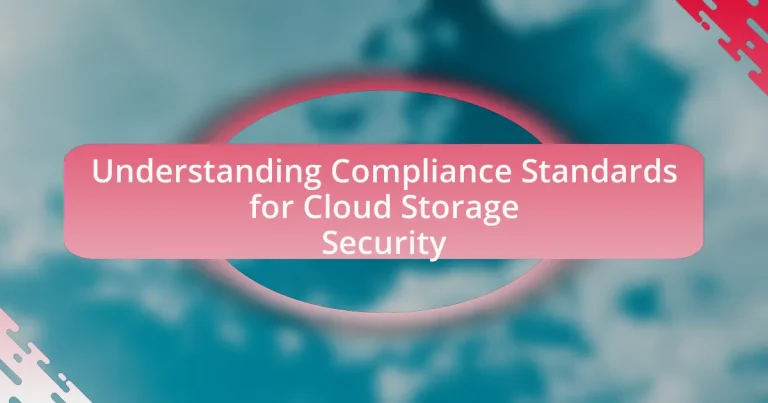Compliance standards for cloud storage security are essential frameworks and regulations that organizations must follow to protect sensitive data in cloud environments. Key standards include the General Data Protection Regulation (GDPR), Health Insurance Portability and Accountability Act (HIPAA), and Payment Card Industry Data Security Standard (PCI DSS), each addressing specific data protection requirements. The article outlines the importance of these standards in mitigating risks such as data breaches and legal penalties, as well as the best practices organizations can adopt to ensure compliance. It also discusses the challenges faced in achieving compliance and the tools available to assist in managing compliance effectively.
What are Compliance Standards for Cloud Storage Security?
Compliance standards for cloud storage security are frameworks and regulations that organizations must adhere to in order to protect sensitive data stored in cloud environments. These standards include regulations such as the General Data Protection Regulation (GDPR), which mandates data protection and privacy for individuals within the European Union, and the Health Insurance Portability and Accountability Act (HIPAA), which sets standards for protecting sensitive patient information in the healthcare sector. Additionally, the Payment Card Industry Data Security Standard (PCI DSS) provides guidelines for organizations that handle credit card information, ensuring secure transactions and data handling. Compliance with these standards is essential for mitigating risks associated with data breaches and ensuring legal accountability.
Why are Compliance Standards important for Cloud Storage Security?
Compliance standards are crucial for cloud storage security because they establish a framework for protecting sensitive data and ensuring regulatory adherence. These standards, such as GDPR and HIPAA, provide guidelines that organizations must follow to safeguard personal and confidential information stored in the cloud. By adhering to these standards, companies can mitigate risks associated with data breaches, enhance customer trust, and avoid significant legal penalties. For instance, non-compliance with GDPR can result in fines up to 4% of annual global turnover or €20 million, whichever is greater, highlighting the financial implications of failing to meet compliance requirements.
How do Compliance Standards protect sensitive data?
Compliance standards protect sensitive data by establishing specific requirements and guidelines that organizations must follow to ensure data security and privacy. These standards, such as GDPR, HIPAA, and PCI DSS, mandate the implementation of security measures like encryption, access controls, and regular audits. For instance, GDPR requires organizations to implement data protection by design and by default, ensuring that personal data is processed securely. Compliance with these standards not only helps organizations mitigate risks of data breaches but also fosters trust with customers by demonstrating a commitment to safeguarding their information.
What risks are mitigated by adhering to Compliance Standards?
Adhering to Compliance Standards mitigates risks such as data breaches, legal penalties, and reputational damage. Compliance Standards, like GDPR and HIPAA, establish protocols that protect sensitive information, ensuring that organizations implement necessary security measures. For instance, organizations that comply with GDPR can avoid fines of up to 4% of annual global turnover, which underscores the financial risk associated with non-compliance. Additionally, adherence to these standards fosters trust with customers and stakeholders, reducing the risk of reputational harm that can arise from data mishandling.
What are the key Compliance Standards relevant to Cloud Storage Security?
The key compliance standards relevant to cloud storage security include the General Data Protection Regulation (GDPR), Health Insurance Portability and Accountability Act (HIPAA), Payment Card Industry Data Security Standard (PCI DSS), and Federal Risk and Authorization Management Program (FedRAMP). GDPR mandates strict data protection and privacy for individuals within the European Union, while HIPAA sets standards for protecting sensitive patient health information in the United States. PCI DSS outlines security measures for organizations that handle credit card information, ensuring secure transactions. FedRAMP provides a standardized approach to security assessment for cloud services used by federal agencies, ensuring compliance with federal security requirements. These standards collectively ensure that cloud storage solutions maintain high levels of security and data protection.
What is the General Data Protection Regulation (GDPR)?
The General Data Protection Regulation (GDPR) is a comprehensive data protection law enacted by the European Union in May 2018. It establishes strict guidelines for the collection, storage, and processing of personal data of individuals within the EU, aiming to enhance privacy rights and protect personal information. The GDPR applies to any organization that processes the personal data of EU residents, regardless of the organization’s location, thereby reinforcing accountability and transparency in data handling practices.
How does the Health Insurance Portability and Accountability Act (HIPAA) apply to cloud storage?
The Health Insurance Portability and Accountability Act (HIPAA) mandates that any cloud storage provider handling protected health information (PHI) must implement specific security measures to ensure the confidentiality, integrity, and availability of that information. HIPAA requires covered entities and their business associates to enter into Business Associate Agreements (BAAs) with cloud service providers, outlining the responsibilities for safeguarding PHI. Additionally, cloud storage solutions must comply with HIPAA’s Privacy Rule and Security Rule, which include requirements for access controls, encryption, audit controls, and data backup. Failure to comply with these regulations can result in significant penalties, including fines and legal action.
What role does the Payment Card Industry Data Security Standard (PCI DSS) play in cloud security?
The Payment Card Industry Data Security Standard (PCI DSS) plays a critical role in cloud security by establishing a framework for protecting cardholder data in cloud environments. PCI DSS outlines specific security requirements that organizations must implement when storing, processing, or transmitting payment card information, ensuring that cloud service providers maintain robust security measures. Compliance with PCI DSS is essential for any business that handles credit card transactions, as it helps mitigate risks associated with data breaches and fraud. According to the PCI Security Standards Council, adherence to these standards can significantly reduce the likelihood of data compromise, thereby enhancing overall cloud security for businesses that rely on cloud storage solutions.
How do organizations ensure compliance with these standards?
Organizations ensure compliance with cloud storage security standards by implementing a combination of policies, procedures, and technologies. They conduct regular audits and assessments to evaluate adherence to established standards such as ISO 27001 or GDPR. Additionally, organizations provide training for employees to understand compliance requirements and utilize automated tools for monitoring and reporting compliance status. These measures are supported by documented evidence of compliance activities, such as audit reports and training records, which demonstrate their commitment to maintaining security standards.
What steps should organizations take to assess their compliance status?
Organizations should conduct a comprehensive compliance assessment by following a structured approach. First, they need to identify applicable regulations and standards relevant to their industry, such as GDPR, HIPAA, or ISO 27001. Next, organizations should perform a gap analysis to compare current practices against these standards, identifying areas of non-compliance. Following this, they should implement necessary changes to policies and procedures to address identified gaps. Additionally, organizations must establish a continuous monitoring system to regularly review compliance status and adapt to any regulatory changes. Finally, documenting all compliance efforts and conducting periodic audits will ensure ongoing adherence to standards. This structured approach is validated by the fact that organizations that regularly assess compliance are better positioned to mitigate risks and avoid penalties.
How can organizations implement best practices for compliance?
Organizations can implement best practices for compliance by establishing a comprehensive compliance framework that includes regular risk assessments, employee training, and adherence to relevant regulations. This framework should be tailored to specific compliance standards, such as GDPR or HIPAA, ensuring that all processes align with legal requirements. Regular audits and monitoring of compliance activities are essential to identify gaps and improve practices. According to a study by the Ponemon Institute, organizations that conduct regular compliance training reduce the risk of data breaches by 45%, highlighting the importance of ongoing education in maintaining compliance.
What challenges do organizations face in achieving compliance?
Organizations face several challenges in achieving compliance, including the complexity of regulations, resource constraints, and the need for continuous monitoring. The complexity arises from the varying compliance standards across different jurisdictions, which can lead to confusion and misinterpretation. Resource constraints, such as limited budgets and personnel, hinder the ability to implement necessary compliance measures effectively. Additionally, continuous monitoring is essential to ensure ongoing compliance, but many organizations struggle to maintain the required level of vigilance due to the dynamic nature of regulations and threats. These challenges are supported by findings from the 2021 Compliance Trends Report, which indicated that 60% of organizations cited regulatory complexity as a significant barrier to compliance efforts.
What are common obstacles to compliance in cloud storage?
Common obstacles to compliance in cloud storage include data security risks, lack of visibility, and regulatory complexity. Data security risks arise from potential breaches and unauthorized access, which can compromise sensitive information. Lack of visibility into data storage and management practices makes it difficult for organizations to monitor compliance effectively. Regulatory complexity stems from varying compliance requirements across different jurisdictions, making it challenging for organizations to adhere to all applicable laws and standards. These factors collectively hinder organizations’ ability to maintain compliance in cloud storage environments.
How can organizations overcome these challenges?
Organizations can overcome challenges related to compliance standards for cloud storage security by implementing robust governance frameworks and continuous training programs. Establishing clear policies and procedures ensures that all employees understand compliance requirements, while regular training updates keep staff informed about evolving regulations. Additionally, leveraging automated compliance tools can streamline monitoring and reporting processes, reducing the risk of human error. According to a report by the Cloud Security Alliance, organizations that adopt automated compliance solutions experience a 50% reduction in compliance-related incidents, demonstrating the effectiveness of these strategies.
How do Compliance Standards evolve with technology?
Compliance standards evolve with technology through the continuous adaptation of regulations to address emerging risks and innovations in digital environments. As new technologies such as cloud computing, artificial intelligence, and blockchain are developed, regulatory bodies assess their implications on data security, privacy, and operational integrity. For instance, the introduction of the General Data Protection Regulation (GDPR) in 2018 was a direct response to the rise of digital data processing and the need for enhanced consumer protection in the European Union. This evolution is further evidenced by the ongoing updates to standards like ISO/IEC 27001, which now incorporate guidelines for cloud security and data management practices that reflect current technological capabilities and threats.
What trends are influencing changes in Compliance Standards?
Emerging technologies, regulatory changes, and increased data privacy concerns are key trends influencing changes in compliance standards. The rise of cloud computing necessitates updated standards to address security vulnerabilities and data protection. For instance, the implementation of the General Data Protection Regulation (GDPR) in Europe has prompted organizations globally to enhance their compliance frameworks to protect personal data. Additionally, the growing adoption of artificial intelligence and machine learning in data processing requires compliance standards to evolve to mitigate risks associated with automated decision-making. These trends collectively drive the need for more robust and adaptive compliance standards in the context of cloud storage security.
How can organizations stay updated on compliance requirements?
Organizations can stay updated on compliance requirements by regularly monitoring regulatory changes and utilizing compliance management tools. These tools often provide real-time updates on relevant laws and standards, ensuring organizations are informed about any modifications that may affect their operations. Additionally, subscribing to industry newsletters, participating in webinars, and engaging with professional associations can further enhance awareness of compliance developments. Research indicates that organizations that actively engage in these practices are better positioned to adapt to evolving compliance landscapes, thereby reducing the risk of non-compliance and associated penalties.
What are the consequences of non-compliance with Cloud Storage Security standards?
Non-compliance with Cloud Storage Security standards can lead to severe consequences, including data breaches, legal penalties, and reputational damage. Organizations that fail to adhere to these standards risk exposing sensitive information to unauthorized access, which can result in financial losses and regulatory fines. For instance, the General Data Protection Regulation (GDPR) imposes fines of up to 4% of annual global turnover for non-compliance, highlighting the financial risks involved. Additionally, companies may face lawsuits from affected customers or partners, further exacerbating their financial and reputational harm.
What legal implications can arise from non-compliance?
Non-compliance with cloud storage security standards can lead to significant legal implications, including fines, penalties, and potential lawsuits. Regulatory bodies, such as the General Data Protection Regulation (GDPR) in Europe, impose strict penalties for breaches, which can reach up to 4% of annual global turnover or €20 million, whichever is higher. Additionally, organizations may face civil lawsuits from affected individuals or entities, resulting in further financial liabilities and reputational damage. Non-compliance can also lead to loss of certifications or licenses necessary for operation, impacting business continuity and market competitiveness.
How does non-compliance affect an organization’s reputation?
Non-compliance negatively impacts an organization’s reputation by eroding trust among stakeholders, including customers, investors, and regulatory bodies. When an organization fails to adhere to compliance standards, it can lead to public scrutiny, legal penalties, and financial losses, which collectively damage its credibility. For instance, a study by the Ponemon Institute found that organizations experiencing data breaches due to non-compliance face an average cost of $3.86 million, which can significantly tarnish their public image and customer loyalty. Additionally, companies like Equifax and Target have faced severe reputational damage and loss of consumer confidence following compliance failures, illustrating the long-term consequences of non-compliance on organizational reputation.
What best practices can organizations adopt for maintaining compliance?
Organizations can adopt several best practices for maintaining compliance, including implementing a robust compliance management system, conducting regular audits, and providing ongoing training for employees. A compliance management system helps organizations track regulations and ensure adherence to legal requirements, while regular audits identify gaps and areas for improvement. Ongoing training ensures that employees are aware of compliance standards and their responsibilities, which is crucial for minimizing risks. According to a study by the Ponemon Institute, organizations that conduct regular compliance training experience 50% fewer compliance violations, highlighting the effectiveness of these practices.
How can regular audits enhance compliance efforts?
Regular audits enhance compliance efforts by systematically identifying gaps and ensuring adherence to established regulations and standards. These audits provide a structured approach to evaluate processes, controls, and policies, allowing organizations to detect non-compliance issues before they escalate. For instance, a study by the Institute of Internal Auditors found that organizations conducting regular audits are 30% more likely to meet compliance requirements consistently. This proactive monitoring not only mitigates risks but also fosters a culture of accountability and continuous improvement within the organization.
What role does employee training play in compliance adherence?
Employee training plays a critical role in compliance adherence by ensuring that employees understand and follow the necessary regulations and standards. Effective training programs equip employees with the knowledge of compliance requirements specific to cloud storage security, such as data protection laws and industry standards like GDPR or HIPAA. Research indicates that organizations with comprehensive training programs experience a 50% reduction in compliance violations, demonstrating the direct impact of training on adherence to compliance standards.
What resources are available for understanding and implementing Compliance Standards?
Resources available for understanding and implementing Compliance Standards include regulatory guidelines, industry frameworks, and training programs. Regulatory guidelines such as the General Data Protection Regulation (GDPR) and the Health Insurance Portability and Accountability Act (HIPAA) provide specific compliance requirements for data protection. Industry frameworks like the National Institute of Standards and Technology (NIST) Cybersecurity Framework and the International Organization for Standardization (ISO) 27001 offer structured approaches to managing compliance. Additionally, training programs from organizations like the Compliance Certification Board (CCB) and online platforms such as Coursera and Udemy provide educational resources to enhance understanding and implementation of compliance standards.
Where can organizations find official guidelines and documentation?
Organizations can find official guidelines and documentation on compliance standards for cloud storage security through government websites, industry associations, and standard-setting organizations. For example, the National Institute of Standards and Technology (NIST) provides comprehensive guidelines, such as NIST Special Publication 800-53, which outlines security and privacy controls for federal information systems. Additionally, the International Organization for Standardization (ISO) offers standards like ISO/IEC 27001, which focuses on information security management systems. These resources are authoritative and widely recognized in the field of cloud security compliance.
What tools can assist in compliance management for cloud storage?
Tools that can assist in compliance management for cloud storage include data loss prevention (DLP) solutions, encryption software, and compliance management platforms. DLP solutions, such as Symantec DLP, help organizations monitor and protect sensitive data stored in the cloud by preventing unauthorized access and data breaches. Encryption software, like VeraCrypt, secures data at rest and in transit, ensuring that only authorized users can access it. Compliance management platforms, such as LogicGate and OneTrust, provide frameworks for tracking compliance with regulations like GDPR and HIPAA, offering audit trails and reporting capabilities to demonstrate adherence to compliance standards. These tools collectively enhance the security and compliance posture of organizations utilizing cloud storage.


